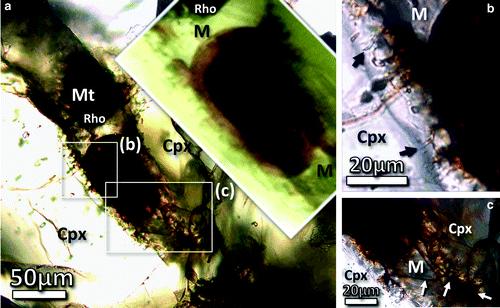Clays are an important mineral group for discovering the past on Mars, not only to the presence of water, since clays are hydrous minerals, but they also provide clues as to the source, type, and volume of fluids, along with indications of timescale and mineral alteration. If you are going to search for textural and chemical biosignatures, clay is a good place to start.
A conspicuous biomorphic ovoid structure has been discovered in the Nakhla martian meteorite, made of nanocrystalline iron-rich saponitic clay and amorphous material. It is indigenous to Nakhla, contains a variety of minerals, and shows evidence of undergoing a past shock event from impact, with resulting melting of the permafrost and mixing of surface and subsurface fluids.

Transmitted light photomicrographs taken in plane polarized light (uncrossed Nicols) of the ovoid structure in Nakhla, highlighting its petrographic context and its distinctive dark reddish-orange to brownish color (inset image is slightly magnified). (a) Overview photomicrograph. The ovoid structure is situated inside a small late-forming pocket of mesostasis materials that is interstitial to two clinopyroxene crystals (Cpx). In detail, the ovoid exhibits a sharp contact with the adjacent amorphous mesostasis phase [see M in inset and in (b) and (c)], which is identified as rhyolitic glass. The opaque phases are Ti magnetite (Mt) and rhoenite (Rho). (b, c) Close-up photomicrographs from (a). Black arrows in photomicrograph (b) indicate conspicuous, orange-stained microchannel features in clinopyroxene rims. White arrows in photomicrograph (c) indicate fractures in the mesostasis M that are stained with iron oxide/hydroxide material (orange to yellow hues) and that extend up to the ovoid structure. Credit: doi:10.1089/ast.2013.1069
Based on the results of a broad range of analytical studies to determine the origin of this new structure, scientists present the competing hypotheses for how this ovoid formed.
Using electron microscopy, x-ray, and spectroscopy to analyze the ovoid structure, they believe they can point to the most likely conclusion.
While the authors do not believe the formation of this structure involved biological materials, that is a possible hypothesis, and they note that evidence exists supporting the presence of niche environments in the Martian subsurface that could support life.
Chatzitheodoridis Elias, Haigh Sarah, and Lyon Ian, 'A Conspicuous Clay Ovoid in Nakhla: Evidence for Subsurface Hydrothermal Alteration on Mars with Implications for Astrobiology', Astrobiology, August 2014, 14(8): 651-693. doi:10.1089/ast.2013.1069.





Comments